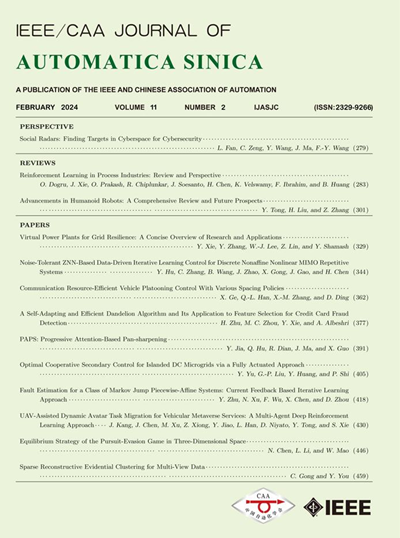An Intelligent Optimization Strategy for Blast Furnace Charging Operation Considering Three-Dimensional Burden Surface Shape
IF 19.2
1区 计算机科学
Q1 AUTOMATION & CONTROL SYSTEMS
引用次数: 0
Abstract
Today, a well-devised charging operation scheme is urgently needed by on-site workmen and is critical for building an intelligent blast furnace (BF). Previous research on charging operations always focused on the two-dimensional shape of the burden surface (i.e., a single radial profile) while neglecting the unique feature of global dissymmetry, severely restricting the development of precise charging. For this reason, this study proposes an innovative optimization strategy for the charging operation under the three-dimensional burden surface, which is the first attempt in this field. First, a practicable region partitioning scheme is introduced, and the partitioning results are then integrated with the charging mechanism to construct a three-dimensional burden surface prediction model. Next, the intrinsic relationship between the operational parameters and charging volume is revealed based on the law of mass conservation, which forms the basis for defining a novel operational parameter with variable-speed utility, referred to as the neotype charging matrix (NCM). To find the best NCM, a customized NCM optimization strategy, involving a dual constraint handling technique in conjunction with a two-stage hybrid variable differential evolution algorithm, is further developed. The industrial experiment results manifest that the partitioning scheme significantly enhances the accuracy of burden surface description. Moreover, the NCM optimization strategy offers greater flexibility and higher accuracy than current mainstream optimization strategies for the charging matrix (CM).考虑三维料面形状的高炉装料操作智能优化策略
目前,现场工人迫切需要一套设计合理的炉料操作方案,这对智能高炉的建设至关重要。以往对装药操作的研究多集中在料面二维形状(即单一径向轮廓)上,忽视了全局不对称的独特性,严重制约了精确装药的发展。为此,本研究创新性地提出了三维料面下的装药操作优化策略,这是该领域的首次尝试。首先,提出了一种可行的区域分区方案,并将分区结果与装药机理相结合,构建了三维料面预测模型。其次,基于质量守恒定律揭示了运行参数与充电量之间的内在关系,为定义具有变速效用的新型运行参数(称为新型充电矩阵)奠定了基础。为了找到最佳的NCM,进一步开发了一种定制的NCM优化策略,该策略包括双约束处理技术与两阶段混合变量差分进化算法相结合。工业试验结果表明,该划分方案显著提高了料面描述的准确性。与目前主流的充电矩阵优化策略相比,NCM优化策略具有更大的灵活性和更高的精度。
本文章由计算机程序翻译,如有差异,请以英文原文为准。
求助全文
约1分钟内获得全文
求助全文
来源期刊

Ieee-Caa Journal of Automatica Sinica
Engineering-Control and Systems Engineering
CiteScore
23.50
自引率
11.00%
发文量
880
期刊介绍:
The IEEE/CAA Journal of Automatica Sinica is a reputable journal that publishes high-quality papers in English on original theoretical/experimental research and development in the field of automation. The journal covers a wide range of topics including automatic control, artificial intelligence and intelligent control, systems theory and engineering, pattern recognition and intelligent systems, automation engineering and applications, information processing and information systems, network-based automation, robotics, sensing and measurement, and navigation, guidance, and control.
Additionally, the journal is abstracted/indexed in several prominent databases including SCIE (Science Citation Index Expanded), EI (Engineering Index), Inspec, Scopus, SCImago, DBLP, CNKI (China National Knowledge Infrastructure), CSCD (Chinese Science Citation Database), and IEEE Xplore.
 求助内容:
求助内容: 应助结果提醒方式:
应助结果提醒方式:


